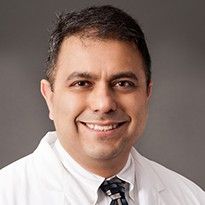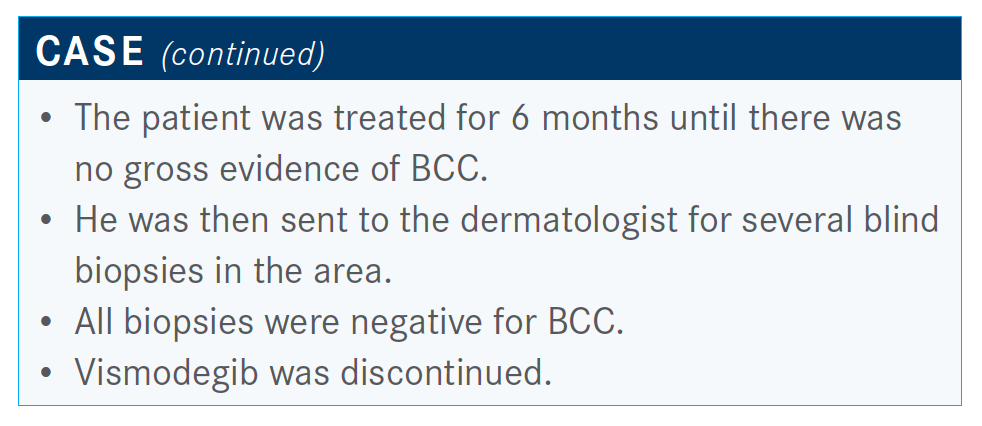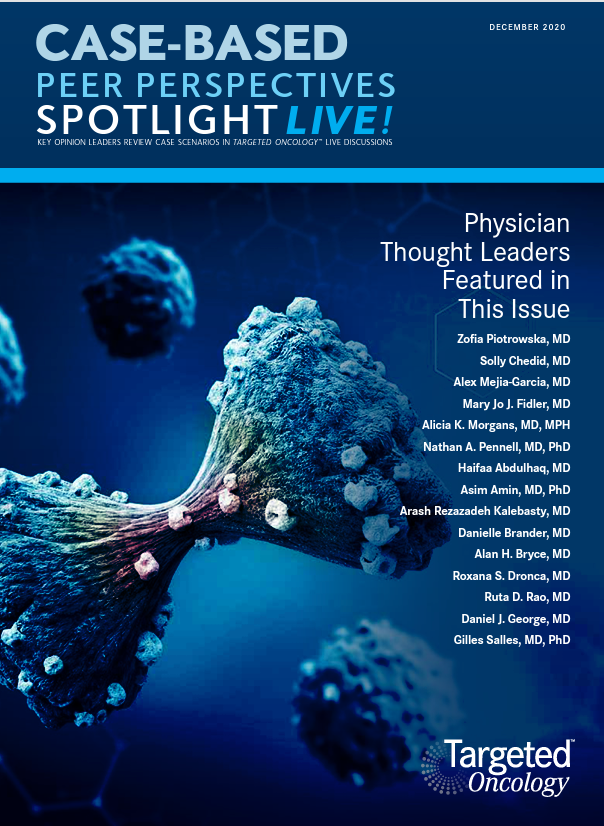Expert Compares Vismodegib and Sonidegib for Treatment of Infiltrative BCC
Solly Chedid, MD, led a discussion with a group of peers about the treatment of infiltrative basal cell carcinoma in a 88-year-old patient during a Targeted Oncology Case-Based Peer Perspectives event.
Solly Chedid, MD

Solly Chedid, MD, an oncologist at Memorial Hermann Memorial City Medical Center in Houston, Texas, led a discussion with a group of peers about the treatment of infiltrative basal cell carcinoma (BCC) in a 88-year-old patient during a Targeted Oncology Case-Based Peer Perspectives event.
Targeted OncologyTM: How would you characterize this patient’s risk status?
CHEDID: I would characterize this [patient] as being high risk. The cure [for this disease is to] surgically remove [the tumor] or give high-dose radiation therapy. In his sinuses right by his eye, it’s going to be hard to get good margins for surgery and he’s going to have a lot of toxicity from the radiation therapy. This patient’s primary options at this point is 1 of the Hedgehog inhibitors.
Do you ever use neoadjuvant therapy to shrink the tumor down despite the lack of data in this setting?
Yes, I have done that with several of my patients. The problem, though, is that we never know exactly how effective we’re getting the margin because it’s going to shrink down, but exactly how much microscopic disease is left? It’s not approved; it’s not FDA indicated. You might have some difficulty, especially from the insurance companies threatening to retroactively affect the charging on these patients.
What are some of the risk factors that affect how you handle this patient?
The risk factors for this patient include that [the disease] is still in area H, which essentially is the mask area of the face.1 Other areas would be genitalia, hands, and feet; those would be considered high-risk features, [as well as if the disease] was poorly defined or if it was recurrent. This patient didn’t have recurrent disease, but he was immunosuppressed. I think a patient who previously had chemotherapy, lymphoma, or transplant prior [to] radiation therapy [is at higher risk]. This patient had an aggressive growth pattern, [but his case] didn’t mention anything about perineural involvement.
Would you consider prescribing a hedgehog pathway for this patient? Is there anything else you would give besides a hedgehog inhibitor?
There are 2 hedgehog inhibitors that are available right now. One is sonidegib [Odomzo], another one is vismodegib [Erivedge].
It’s a [situation] where there are some various chemotherapy options that are available, but it’s nothing that has good data behind it.

How long would you treat this patient for? What factors drive the selection of one hedgehog pathway inhibitor over another?
The package insert says until disease progression or unacceptable toxicity. I would [keep going until you lose the response].
In my mind, the major difference is the pharmacologic difference between these agents. Sonidegib has to be given an hour before or…2 hours after meals and has [multiple] drug interactions. Vismodegib doesn’t have anywhere near as many drug interactions, so that’s a plus. Aside from that, I think they’re remarkably similar agents.

What do you think of the patient’s case so far? Are there any other differences between the 2 hedgehog inhibitors that are relevant for treating such patients?
That’s not how I would treat this patient. I’d probably continue therapy for a longer period of time, but you definitely have the option [to stop] if you like.
The indications [for vismodegib] are for locally advanced BCC or metastatic BCC, whereas for sonidegib it’s only for locally advanced BCC.2 They’re both 1 pill a day, 150 mg versus 200 mg [for vismodegib and sonidegib, respectively]. They both have [alternative] options in terms of dose adjusting. The timing for vismodegib is with or without food versus sonidegib, which is indicated for 1 hour before or 2 hours after [meals].
For the drug interactions, they both have some. For sonidegib, they recommend avoiding the CYP3A inhibitors, whereas for vismodegib there’s a minor substrate of CYP2C9 and CYP3A4; I rely on my pharmacist to help me out with these things. Otherwise, there’s no significant drug interactions. Vismodegib, in my mind, is the cleaner of the agents and usually the one that I go with. They both can cause muscle spasms, arthralgias, alopecias, anorexia, weight loss, nausea, vomiting, and fatigue, as well as increased creatine kinase.
How do patients respond to each of these hedgehog inhibitors?
The response rates for locally advanced disease for the vismodegib is 43% versus 30% for metastatic disease. With sonidegib, the locally advanced response rate was virtually identical at 44%.3
The phase 2 trial of vismodegib for patients with locally advanced and metastatic BCC was independently assessed for overall response rate. It was considered [to be] 30% for the metastatic BCC and 43% for the locally advanced BCC. The vast majority of patients had [some] sort of response or at least stabilization of disease.
How do you mitigate the adverse effects (AEs) of hedgehog inhibitors? What has been your experience with managing these AEs?
For alopecia, it causes decreased dermal papillae hair function, so using minoxidil 5% twice a day is a potential option. It causes decreased myogenic factors and increased injury recovery; a recommendation is to use the amino acid L-carnitine or amlodipine 10 mg a day for the muscle spasms. For dysgeusia or ageusia—not being able to taste or tasting things as being… metallic [and which] reduces the bitter and sweet responsivity and decreases taste buds—it’s recommended to do a nutrition consult to make sure [patients] don’t lose too much weight. If they are losing weight, then increase their glucose uptake but also have a nutrition consult.
In my experience, sometimes the muscle spasms can be significant, so they’re recommending a calcium channel blocker. I’ve used antispasmatic agents, although then you have the AEs of fatigue and decreased energy with those.
I’m not sure how difficult [L-carnitine] is to get [for muscle spasms]. I’ve usually told my patients to go to the nutraceutical store and pick it up from there. I’m not sure exactly how much L-carnitine they’re getting in whatever they’re buying that says L-carnitine. Some people say it helps, some people say it doesn’t. The nice thing is that it’s an easy thing for them to try, and they can usually mix it in with something else.…It tastes [unpleasant], from my understanding; it has a very metallic taste.
What options are available for patients with progressive BCC on or after hedgehog pathway inhibitor therapy?
Our options are slim and don’t have a lot of data behind them. We can use a platinum-based chemotherapy, anthracycline-based chemotherapy, an immune checkpoint inhibitor, or a clinical trial.
Most of us would rather use the checkpoint inhibitor or [something besides chemotherapy]. [Platinum-based chemotherapy] is a reasonable option. There are some data behind it. Unfortunately, the efficacy is not quite as large as I would hope it to be. But there are patients for whom immune checkpoint inhibitors might not be an option.
Are there data for using a checkpoint inhibitor for this patient population?
There was a clinical trial using combination immunotherapy nivolumab [Opdivo] plus ipilimumab [Yervoy] in patients with locally advanced, unresectable or metastatic BCC [NCT03521830]. It’s a phase 2 study with 2 cohorts of locally advanced or metastatic BCC. Cohort A had patients in the first line or [if they had been] previously treated, and they received nivolumab at 480 mg every 4 weeks. Cohort B [had patients] after [they had taken] another anti–PD-1 inhibitor, including patients who had progressive disease after 16 weeks on cohort A, and they were given nivolumab plus ipilimumab.
The end point was objective response rate, which was either complete response or partial response. But in my mind, even stabilization of disease is not necessarily a bad end point considering we don’t have a lot of other options. The secondary end points were stabilization of disease added to the complete and partial response [for disease control rate], but you wanted to have stabilization of disease of greater than or equal to 26 weeks’ duration as well as overall survival and progression-free survival. For the exploratory end point, they did some interrogation of the tumor mutational burdens in the pre- and on-therapy biopsies.
What new data are out for the use of therapy in patients who have progressed on hedgehog pathway inhibitors?
The study of cemiplimab [Libtayo] in patients with BCC previously treated…with a hedgehog pathway inhibitor is another situation where you had a single-arm open-label trial [NCT03132636].4 The overall response rate was 31% for locally advanced disease4 and 21% for metastatic disease.5 The estimated duration of response over a year was 85.2% for patients with locally advanced BCC and 83% for patients with metastatic BCC. [The percentage of] patients who had durable complete response, which was defined as lasting at least 6 months, was 60% versus 46%, respectively.5
References:
1. NCCN. Clinical Practice Guidelines in Oncology. Basal cell skin cancer, version 1.2020. Accessed November 24, 2020. https://bit.ly/38HAZT4
2. Harris L. Basal cell carcinoma: a pharmacist’s guide. US Pharm. 2019;44(8):29-35. Accessed November 30, 2020. https://bit.ly/2G4vNz3
3. Sekulic A, Migden MR, Oro AE, et al. Efficacy and safety of vismodegib in advanced basal cell carcinoma. N Engl J Med. 2012;366(23):2171-2179. doi:10.1056/NEJMoa1113713
4. Stratigos AJ, Sekulic A, Peris K, et al. Primary analysis of phase II results for cemiplimab in patients (pts) with locally advanced basal cell carcinoma (laBCC) who progress on or are intolerant to hedgehog inhibitors (HHIs). Ann Oncol. 2020;31 (suppl 4):S1175-S1176. doi:10.1016/annonc/annonc325
5. Libtayo (cemiplimab) shows clinically meaningful and durable responses in second-line advanced basal cell carcinoma. Press release. Sanofi. May 5, 2020. Accessed September 30, 2020. https://bit.ly/3ihdVOg

Survivorship Care Promotes Evidence-Based Approaches for Quality of Life and Beyond
March 21st 2025Frank J. Penedo, PhD, explains the challenges of survivorship care for patients with cancer and how he implements programs to support patients’ emotional, physical, and practical needs.
Read More